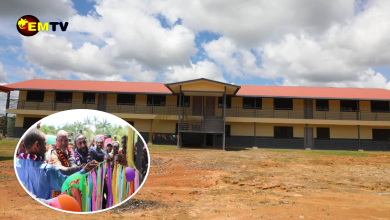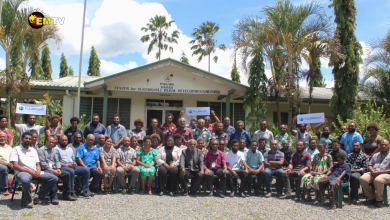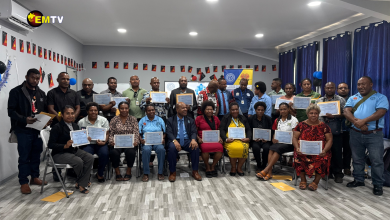By Kilala Devette-Chee
Being able to read and write are fundamental skills every Papua New Guinean must learn to be proficient in at this time and age. Gone are the days when a person did not really care about these skills as they could still survive in the traditional societies.
Today, a person has to master these skills in order to survive and improve the quality of their lives and contribute to a country’s economy. This Spotlight discusses the importance of literacy in Papua New Guinea (PNG). Through a desk review, the following are being discussed: 1) the origins of literacy in PNG,
2) concerns of low literacy level, 3) reported studies on low literacy level in PNG, 4) why PNG still has a low literacy rate and 5) recommendations on possible
solutions to reduce illiteracy.
The origins of literacy in Papua New Guinea
The origins of literacy in Papua New Guinea Literacy in PNG began to emerge during early colonization (late1800s – the 1940s) when missionaries were allowed by the colonial government to teach Papua New Guineans how to read and write in their local vernacular or lingua franca (Tok Pisin or Hiri
Motu).
There was a transfer to English (or German) for those who continued education (Petterson, 2013). The colonial government’s objectives for education and
literacy were to pacify the indigenous population, to prepare workers for low-level government and business positions, and to teach in primary schools. When
Australia took control after World War II, it banished all schools using vernacular languages and established English as the official language of instruction, and laid
the foundation for modern education in PNG (Ahai, 2004). After so much debate about the outcomes-based curriculum which failed the bulk of PNG’s primary and
secondary schools students, many of whom are semiliterate and are now struggling to obtain employment and live a comfortable life, the government introduced the Standard-Based Curriculum with English as the language of instruction.
Concerns on the low literacy level in Papua New Guinea Literacy in PNG has been the centre of national discussions since post-Independence days. For the past 20 years, PNG’s literacy rate has been increasing marginally. In 2000, it was 57.3 percent; in 2010, it was 61.6 percent which was an increase of 4.26 percent
(http://uis.unesco.org/en/country/pg), and in 2015, it was 63.4 percent – an increase of 1.8 percent (https://postcourier.comm.pg/literacy-rate-remains-low/).
In a recently published report by the Education Sector Implementation Grant and Multiplier (in BEST PNG, 2019), just 23.7 percent of grade 5 students nationally reached the expected proficiency level for literacy, lower than the regional Pacific neighbours. This is confirmed by the Pacific Islands Literacy and Numeracy Assessment report 2015 (Educational Quality Assessment Program, 2016), which reported that student’s proficiency level in literacy in PNG was 14.33 percent compared to the Pacific Regional rate of 17.78 percent.
Although there has been a slight improvement in the literacy rate, it is questionable as to why the literacy rate has been increasing at a low pace in the last two decades. According to Petterson (2013), people who have claimed that literacy levels are low as expressed in the daily newspapers, blogs, and social media, is due to the ever-changing education reforms which include;
1) the introduction of elementary schools into the education structure in 1994,
2) the curriculum change to support literacy in community/vernacular languages in elementary schools in 1994, and
3) the introduction of Outcomes-Based Education (OBE) in 2004 (Petterson, 2013) and now the Standard-Based Curriculum (SBC) which is being introduced to all schools throughout PNG this year.
The Education Sector Implementation Grant and Multiplier (2019) on the other hand, reports that the root causes of the poor literacy learning outcomes include weak teaching skills and knowledge, diverse languages, frequent teacher and student absenteeism, and lack of appropriate reading
books and teaching support materials.
Some reported studies on low literacy levels in some parts of PNG
A number of literacy studies that were conducted in some parts of Papua New Guinea showed some alarming results.
- In 2011, a report was released by the Asia South Pacific Association for Basic and Adult Education (ASPBAE, 2011) and the PNG Education Advocacy Network (PEAN) on Education Experience Surveys and Literacy Assessments in five provinces in PNG. The first two surveys were conducted in the National Capital District (NCD) and New Ireland Province in 2006 and 2007, while the three surveys of Simbu, Sandaun, and Gulf provinces were conducted from 2009 to 2011. The findings revealed that more than 70 percent of respondents in all five provinces self-declared confidence in their ability to read and write in a national language. However, actual literacy rates in four of the five provinces were less than 15 percent, while in New Ireland Province, the literacy rate was 25 percent. These poor literacy rates are even more alarming given that the literacy test used was not difficult.
- From 2010 to 2012, a literacy study in the western part of Gulf, carried out by Petterson (2013) on literacy levels of students attending elementary and primary schools, revealed that out of the 292 students that were tested in 13 schools, only 4 percent learned to read well and more than 50 percent had no idea how written language works. This was in classes where children were taught reading in English only. But when children were taught in their own languages 30 percent learned to read well. This in turn shows that; 1) too few children are becoming good readers and 2) when children are taught literacy in their own language, they are about seven times more successful at acquiring literacy than if taught in English only.
- A bilingual language education study in 2009 to 2010 (Devette-Chee, 2014) in six schools in the Kokopo District of East New Britain found that the majority of the students in the sample tested (142 students) failed to master the basic skills of English speak, read and write English).
- From 2017 to 2018, a literacy and numeracy assessment and school survey (Smith and Simoncini, 2018) were conducted in schools in Central, Madang, and Morobe provinces. The literacy and numeracy assessment was completed by 1154 children from the 2017 Elementary 1(E1) cohort from 79 schools. The purpose of the baseline assessment was to identify children’s current literacy and numeracy skills and school status. Findings revealed that approximately 26 percent of the children could correctly identify all the letters of the alphabet. Around 88 percent of the children could identify half or more of the letters. Only 3 percent of children could read all the most frequently used words in English. Around one-third of children (36%) could not read any of the words. Slightly more children could read all the most frequently used words in Tok Pisin (4%). However, 49 percent of children could not read any of these words. This study reveals that in general, children’s literacy skills are not meeting the required standards of the new Standard-Based Curriculum.
Although these reports do not reflect PNG as a whole, they indicate that there are deficiencies in some systems of education implemented so far that need thorough investigation in order to improve the levels of literacy in the provinces in which the studies were conducted.
Why does PNG still have a low literacy rate?
The reasons many Papua New Guineans are still illiterate are many and varied. Those that are common nationwide are:
- Lack of affordable education facilities and learning resources: According to an NRI nationwide study (Devette-Chee and Norea, 2021 forthcoming), children who live in remote areas with a lack of educational learning resources and facilities may remain illiterate. Schools that are not easily accessible by children due to geographical terrains also contribute to illiteracy.
- The failed “Bridging to English Approach” in the Outcomes-Based Education/Curriculum: The current generation of Papua New Guineans who were schooled in the Bilingual Education approach that was practiced in the OBE era had a lot of difficulties learning to read and write. The system failed a lot of students in terms of mastering literacy (reading and writing) skills. According to Devette- Chee (2014), some of the teachers in her study reported that they were not first-language speakers of the students they taught in the bridging grade transitioning from vernacular languages to English. Instead, they used Tok Pisin which was a great disadvantage to children who did not know how to speak the pidgin language.
- Illiteracy among parents: In PNG, parents who are illiterate have difficulties assisting with their children’s education, especially reading and writing. Sadly, children who are born to illiterate parents end up illiterate too. This scenario is true in rural or remote parts of PNG where parents who belong to the older generation did not have any formal schooling.
- Inadequate awareness: Mindsets of parents need to change. In some parts of PNG, some people think that the only reason they should send their child to school is for employment purposes and to attain a good life. This needs to change so they can help their children become literate which is part of the lifelong learning process.
- Social barriers and gender: Some social barriers in some parts of PNG such as restrictions on girls’ education leads to illiteracy among the affected population. Education of the girl child has been an issue in some parts of PNG where the boy child is given the first preference in a family to attend school.
- Poverty: Parents with very low or no income at all have difficulties paying school fees for their children. They are forced to choose between putting their children to school or buying the basic necessities for their family such as food, shelter, clothing, etc.
Recommendations on possible strategy to reduce illiteracy rate
- Free education: Review the provision of free education in schools which was introduced by
the O’Neill-Dion Government. As such, the government will be playing a major role in reducing the level of illiteracy in the country by getting more people to school. Since some people do not attend school due to lack of money to pay for the fees, that was introduced in 2020. Offering free education can increase the number of people attending school and subsequently reduce illiteracy levels within a society. - Awareness: Creating awareness about the importance of education can help people understand why they need to go to school. Non-governmental organisations, civil society organisations, government agencies, and other concerned parties should put in place deliberate measures to create awareness in the society and reduce the number of people who are unable to read and write.
- Night classes: Working people can opt for night classes. In this way, they can learn even as they earn income through their daytime jobs.
- Re-establishing school libraries: In a study by Devette-Chee et al. (2021, Forthcoming), most schools surveyed do not have a library. In building their libraries, the culture of reading will be brought back to schools.
Literacy level in different parts of Papua New Guinea has continued to be a matter of national concern. Although the government has taken a number of measures to improve literacy in the country, more and more students who are dropping out of school are either semi-literate or illiterate. This is a result of, among many factors, the OBE which promoted the use of vernacular languages in elementary schools with a transition period to English in Grade 3. This bilingual program is an excellent concept and has worked well in other countries however, it failed a lot of Papua New Guinean students due to improper implementation of the program.
This is the latest PNG NRI research report, published as Spotlight Volume 14, Issue 7. The paper discusses the importance of literacy in Papua New Guinea and is written by Dr. Kilala Devette-Chee, Senior Research Fellow and Education Research Program Leader.






